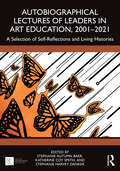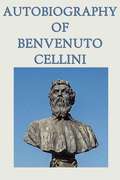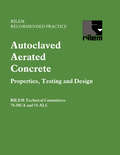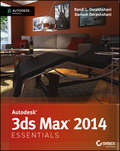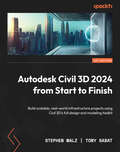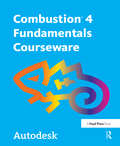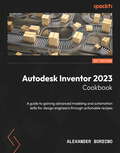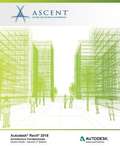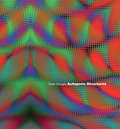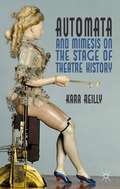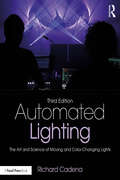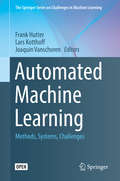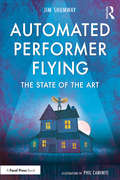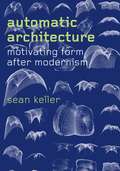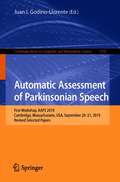- Table View
- List View
Autobiographical Lectures of Leaders in Art Education, 2001–2021: A Selection of Self-Reflections and Living Histories
by Stephanie Autumn Baer Katherine Coy Smith Stephanie Harvey DankerThis scholarly collection is a continuation of a lecture series highlighting the essential nature of biography in the history of art education. The editors feature 16 prominent art educators, organized into one of three chronological sections spanning the past two decades. The contributing art educators explore influences that shaped their beliefs about art education and the arts, describe their career paths, explain their philosophy of art education and its development, and advise, predict, or speculate about the future. Every chapter concludes with essential questions and instructional resources to guide readers in their reflection. In reading these lectures, art education faculty, students, and any adjacent professional to the arts and art history can learn the importance of biographical and autobiographical study to research. Beyond research, readers can use the lectures to consider and question teaching and mentoring relationships, the power of influence, and what qualities may contribute to the recognition of exemplary success for art educators.
Autobiography of Benvenuto Cellini
by Benvenuto CelliniBenvenuto Cellini was a celebrated Renaissance sculptor and goldsmith; a passionate craftsman who was admired and resented by the most powerful political and artistic personalities in sixteenth-century Florence, Rome and Paris. He was also a murderer and a braggart, a shameless adventurer who at different times experienced both papal persecution and imprisonment, and the adulation of the royal court. Inn-keepers and prostitutes, kings and cardinals, artists and soldiers rub shoulders in the pages of his notorious autobiography: a vivid portrait of the manners and morals of both the rulers of the day and of their subjects. Written with supreme powers of invective and an irrepressible sense of humour, this is an unrivalled glimpse into the palaces and prisons of the Italy of Michelangelo and the Medici.
Autocad And Its Applications Basics 2015
by David Madsen Terence ShumakerAutoCAD and Its Applications: Basics 2015 provides instruction for mastering AutoCAD commands and drawing and dimensioning techniques. The text provides complete coverage of 2D AutoCAD drafting and design. Topics are presented in an easy-to-understand sequence, building upon prior chapter knowledge. ASME standards are referenced throughout the text and examples and illustrations focus on industry practices.
Autocad and Its Applications 2012: Comprehensive
by David A. Madsen David P. Madsen Terence M. Shumaker Craig P. Black Adam M. Ferris Jeffrey A. Laurich J. C. MalitzkeThe Comprehensive edition of AutoCAD and Its Applications combines the complete contents of the Basics and Advanced editions to provide flexibility in course design and teaching approaches. This package provides a complete program for teaching introductory and second-tier AutoCAD courses.
Autoclaved Aerated Concrete - Properties, Testing and Design
by S. AroniThis is a comprehensive guide to autoclaved aerated concrete (AAC) for designers, specifiers, users and manufacturers. It provides a model code of practice for the structural use of AAC and provides designers with a complete guide to the structural use of AAC in structural applications in building.
Autodesk 3ds Max 2012 Essentials
by Dariush Derakhshani Randi L. DerakhshaniGet a jump-start on Autodesk 3ds Max 2012 essentials--with the Essentials! The new Essentials books from Sybex are beautiful, task-based, full-color Autodesk Official Training Guides that help you get up to speed on Autodesk topics quickly and easily. Autodesk 3ds Max 2012 Essentials thoroughly covers the fundamentals of this popular 3D animation effects, and visualization software, teaching you what you need to become quickly productive. By following the book's clear explanations, practical tutorials, and step-by-step exercises, you'll cover all the bases. Topics include modeling, animation, rendering, rigging, compositing, and much more. Whether you're an aspiring 3D designer or a professional brushing up on the basics, here is the essential grounding you need in 3ds Max 2012. Covers Autodesk 3ds Max 2012 fundamentals, so you become quickly productive with the software Uses straightforward explanations and real-world, hands-on exercises and tutorials to teach the software's core features and functions Helps you develop the skills you'll need throughout an animation production pipeline, whether you're a beginner or a more experienced user brushing up on the basics Uses a task-based approach and covers topics such as polygon modeling, materials and mapping, lighting, using mental ray, HDRI images, and more This book is an Autodesk Official Training Guide If you want to get quickly up to speed on 3ds Max, Autodesk 3ds Max 2012 Essentials is the place to start.
Autodesk 3ds Max 2014 Essentials: Autodesk Official Press
by Dariush Derakhshani Randi L. DerakhshaniGreat guide to the fundamentals of Autodesk 3ds Max 2014 This Autodesk Official Press guide is just what you need to learn the basics of Autodesk 3ds Max 2014 quickly and easily. Through a series of cool projects like designing an alarm clock, animating a thrown knife, or lighting a scene, you'll learn the essentials of modeling, rigging, animating, and rendering using the popular Autodesk 3ds Max 3D animation and effects software. It's a practical, hands-on approach allowing you to constantly reinforcing skills as you learn them. Downloadable before-and-after project files let you to compare your work to that of 3ds Max professionals. Even if you already have experience with 3ds Max, this book is a great reference for renewing your skills. And, it will help all users review and prepare for the Autodesk 3ds Max 2014 certification exams. Helps beginners and those migrating from other 3D animation and effects programs get up and running on Autodesk 3ds Max 2014 Features a realistic, task-based approach, so readers learn via a series of hands-on projects using downloadable files, all backed with ample instruction, explanation, and illustration Covers modeling, rigging, animating, rendering, skinning, architectural visualization, and more Written by Autodesk Authorized Authors and is an Autodesk Official Press book Get firsthand experience with 3ds Max, as well as a good start on preparing for the Autodesk 3ds Max 2014 Certified Professional exam, with Autodesk 3ds Max 2014 Essentials.
Autodesk AutoCAD 2013 Practical 3D Drafting and Design
by Joao SantosThis book is written in a practical and friendly style with practical tutorials, exercises, and detailed images which will help you master the third dimension. This book is intended for everyone who wants to create accurate 3D models in AutoCAD, like architecture, engineering, or design professionals, and students. Only basic understanding of 2D AutoCAD is needed.
Autodesk Civil 3D 2024 from Start to Finish: A practical guide to civil infrastructure design, modeling, and analysis
by Stephen Walz Tony SabatMaster Autodesk Civil 3D 2023 to develop real, project-specific, time-efficient civil infrastructure designs as an individual or an entire engineering teamPurchase of the print or Kindle book includes a free PDF eBookKey FeaturesReap the potential of Civil 3D and its partner software platformsScale your workflows with a larger team and bigger projects while maximizing productivityExplore the design and modeling tools for enhanced functionality in Civil 3DBook DescriptionAutodesk Civil 3D can radically increase your civil engineering design and efficiency if you learn to make the most of its features and partner software platforms. Autodesk Civil 3D from Start to Finish will teach you how to leverage its strengths and scale efficiency to large teams. With this book, you'll uncover all the major features Civil 3D offers, from surface development to intelligent utility design as well as dynamic display work for smart document creation. You'll learn to configure and manage your civil engineering designs and explore practical applications of tools and modeling techniques available within the software. By the end of this book, you'll have a thorough understanding of Autodesk Civil 3D along with its partner programs to strategize and improve your future projects.What you will learnUnderstand civil project basics and how Autodesk Civil 3D helps achieve themConnect detailed components of your design for faster and more efficient designsEliminate redundant workflows by creating intelligent objects to handle design changes smoothlyCollaborate with distributed teams efficiently and produce designs swiftly and effectivelyOptimize 3D usage and decision-making, using a model-based approach on the impact of your designs and accelerate your careerWho this book is forThis book is for Civil Engineers, Environmental Engineers, Surveyors, Civil Designers, Civil Technicians, Civil 3D Professionals and InfraWorks Professionals looking to understand how to best leverage Civil 3D in their everyday designs. You'll need to have a very basic understanding of Civil Engineering and Surveying workflows as well as a foundational understanding of Autodesk's AutoCAD to make the most of this book. Basic understanding of Surveying, Civil/Environmental Engineering practices, and AutoCAD drafting knowledge is assumed.
Autodesk Civil 3D 2024 from Start to Finish: Build scalable, real-world infrastructure projects using Civil 3D's full design and modeling toolkit
by Stephen Walz Tony SabatStreamline your entire civil design workflow—from data management to sheet automation—using Civil 3D 2024Key FeaturesLeverage Civil 3D and partner tools for seamless project integrationMaximize productivity with scalable team workflows and automationEnhance your Civil 3D workflow with smarter design and modeling toolsBook DescriptionCivil infrastructure projects demand precision, collaboration, and the ability to adapt to design changes quickly. This book shows how Civil 3D 2024 can help you streamline workflows, reduce rework, and improve project accuracy—whether you're working solo or in a large engineering team. You'll learn how to set up your environment, manage survey data, and model surfaces, alignments, profiles, and utilities using Civil 3D’s comprehensive toolset. With a strong focus on real-world design practices, this book demonstrates how to use intelligent objects and dynamic documentation features to handle changes efficiently across distributed teams. You’ll also work with partner tools that enhance Civil 3D’s capabilities, ensuring you can manage data at scale, produce accurate documentation, and deliver designs that meet stakeholder expectations. Written by seasoned civil engineers and Autodesk-certified professionals, this book brings together best practices, project-specific workflows, and insights into maximizing productivity with Civil 3D and its companion tools.What you will learnSet up a Civil 3D environment tailored to your project needsConfigure survey data and create intelligent objectsModel surfaces, alignments, profiles, and utilities accuratelyAutomate sheet creation and streamline documentationCollaborate with teams using data shortcuts and shared referencesApply Civil 3D tools to real-world infrastructure challengesUse partner software for extended design and analysis workflowsWho this book is forThis book is for Civil Engineers, Environmental Engineers, Surveyors, and Infrastructure Designers seeking to optimize their design workflows with Civil 3D. A basic understanding of civil engineering practices and AutoCAD is required.
Autodesk Combustion 4 Fundamentals Courseware
by AutodeskWhether this is your first experience with Combustion software or you're upgrading to take advantage of the many new features and tools, this guide will serve as your ultimate resource to this all-in-one professional compositing application. Much more than a point-and-click manual, this guide explains the principles behind the software, serving as an overview of the package and associated techniques. Written by certified Autodesk training specialists for motion graphic designers, animators, and visual effects artists, Combustion 4 Fundamentals Courseware provides expert advice for all skill levels.
Autodesk Inventor 2023 Cookbook: A guide to gaining advanced modeling and automation skills for design engineers through actionable recipes
by Alexander BordinoWith a recipe-based approach, hone and develop the necessary skills you need to perform mechanical, visualization, and simulation tasks using Autodesk InventorKey FeaturesCreate powerful parametric 3D designs, parts, and assembliesApply effective modeling techniques to increase automation and promote configurationEnable iLogic-powered rapid configurations and apply Finite Element Analysis for model simulationBook DescriptionAutodesk Inventor is an industry-leading, computer-aided design application for 3D mechanical design, simulation, visualization, and documentation. This book will help to bridge the gap between the fundamentals of this software and the more advanced features, workflows, and environments it has to offer.Using cookbook-style recipes, you'll gain a comprehensive understanding and practical experience in creating dynamic 3D parts, assemblies, and complete designs. You'll also explore a variety of topics, including automation and parametric techniques, collaboration tools, creating sheet metal designs, and design accelerators such as frame generators. As you progress, the chapters will guide you through surface modeling tools, advanced assembly, and simplification tools, along with covering iLogic, Finite Element Analysis, and more.By the end of this book, you'll not only be able to use the advanced functionality within Autodesk Inventor but also have the practical experience you need to deploy specific techniques in your own projects and workflows.What you will learnBuild upon the fundamentals of parts, assemblies, and drawingsUnderstand how to use advanced modeling tools such as iFeatures, iLogic, and moreDevelop your experience with parametric design methodologiesExplore surface modeling and project management techniquesDesign efficiently with design accelerators to drive automationUnderstand and apply Finite Element AnalysisWho this book is forThis book is for CAD engineers, mechanical/design engineers, and product designers who have a basic understanding and experience of Inventor fundamentals. It aims to guide and coach you past the basics and into the advanced functionality of the software and environments within it.
Autodesk Maya 2014 Essentials
by Paul NaasThe premiere book on getting started with Maya 2014Whether you're just beginning, or migrating from another 3D application, this step-by-step guide is what you need to get a good working knowledge of Autodesk Maya 2014. Beautifully illustrated with full-color examples and screenshots, Autodesk Maya 2014 Essentials explains the basics of Maya as well as modeling, texturing, animating, setting a scene, and creating visual effects. You'll absorb important concepts and techniques, and learn how to confidently use Maya tools the way professionals do.Each chapter includes fun and challenging hands-on projects, which you can do as you go using the downloadable files from the book's website. They include starting and ending files, so you can compare your results to how professionals do the projects. This information-packed Autodesk Official Press book also helps you prepare for the Autodesk Maya 2014 certification exams. Helps beginners and those migrating from other 3D animation and effects programs get up and running on Autodesk Maya 2014Features step-by-step tutorials, hands-on exercises with downloadable files, and four-color examples and screenshotsCovers modeling, texturing, animating, visual effects, lighting, compositing, setting a scene, and moreWritten by an Autodesk Authorized Author and is an Autodesk Official Press Autodesk Maya is the industry-leading 3D animation and effects software used in movies, games, cartoons, short films, commercials, and other animationGet firsthand experience with Maya 2014, as well as an initial start on preparing for the Autodesk Maya 2014 Certified Professional exam, with Autodesk Maya 2014 Essentials.
Autodesk Revit 2018: Architecture Fundamentals
by ASCENT - Center for Technical Knowledge<p>The Autodesk Revit software is a powerful Building Information Modeling (BIM) program that works the way architects think. The program streamlines the design process through the use of a central 3D model, where changes made in one view update across all views and on the printable sheets. <p>This student guide is designed to teach you the Autodesk Revit functionality as you would work with it throughout the design process. You begin by learning about the user interface and basic drawing, editing, and viewing tools. Then you learn design development tools including how to model walls, doors, windows, floors, ceilings, stairs and more. Finally, you learn the processes that take the model to the construction documentation phase. <p>Since building projects are extremely complex, the Autodesk Revit software is also complex. The objective of the Autodesk(R) Revit(R) 2018 Architecture: Fundamentals student guide is to enable students to create full 3D architectural project models and set them up in working drawings. This student guide focuses on basic tools that the majority of users need. <p>Topics Covered: <p> <li>Understanding the purpose of Building Information Management (BIM) and how it is applied in the Autodesk Revit software. <li>Navigating the Autodesk Revit workspace and interface. <li>Working with the basic drawing and editing tools. <li>Creating Levels and Grids as datum elements for the model. <li>Creating a 3D building model with walls, curtain walls, windows, and doors. <li>Adding floors, ceilings, and roofs to the building model. <li>Creating component-based and custom stairs. <li>Adding component features, such as furniture and equipment. <li>Setting up sheets for plotting with text, dimensions, details, tags, and schedules. <li>Creating details.</li> <p> <p>Prerequisites: <p> <li>An understanding of architectural terminology is an asset.</li>
Autogenic Structures
by Evan DouglisThis book offers an alternative vision for the future of architecture, a timely and invaluable contribution to the debate concerning emergent surfaces and the next generation of building membranes in this era of extreme computational control. Areas covered include: the future relationship between structure and ornament the value of mass customization for the next generation of modular building components the role of smart materials in creating a sustainable universe. Critical essays are combined with cutting-edge work to form an inspiring manual of varied digital and analog techniques. Highly illustrated with over 300 photographs, illustrations, and drawings, Autogenic Structures is for anyone curious to learn about a visionary approach to the development of architecture.
Autogenous Shrinkage of Concrete: Proceedings Of The International Workshop Organized By Jci (japan Concrete Institute)
by Ei-Ichi TazawaThis book forms the proceedings of a workshop held in Hiroshima in June 1998 and derive from the work of a Technical Committee of the Japan Concrete Institute. Topics include test and prediction methods, the science of autogenous shrinkage, strain and stress, and consequent design concerns.
Autographic Design: The Matter of Data in a Self-Inscribing World (metaLAB Projects)
by Dietmar OffenhuberAn ambitious vision for design based on the premise that data is material, not abstract.Data analysis and visualization are crucial tools in today's society, and digital representations have steadily become the default. Yet, more and more often, we find that citizen scientists, environmental activists, and forensic amateurs are using analog methods to present evidence of pollution, climate change, and the spread of disinformation. In this illuminating book, Dietmar Offenhuber presents a model for these practices, a model to make data generation accountable: autographic design.Autographic refers to the notion that every event inscribes itself in countless ways. Think of a sundial, for example—a perfectly autographic device that displays information on itself. Inspired by such post-digital practices of visualization and evidence construction, Offenhuber describes an approach to visualization based on the premise that data is a material entity rather than an abstract representation. Emerson wrote, &“Every act of the man inscribes itself in the memories of his fellows, and in his own manners and face.&” In Autographic Design, Offenhuber introduces a model for design that emphasizes traces, imprints, and self-inscriptions, turning them into sensory displays.In an age where misinformation is harder and harder to identify, Autographic Design makes an urgent and persuasive case for a different approach that calls attention to the production of data and its connection to the material world.
Automata and Mimesis on the Stage of Theatre History
by Kara ReillyThe automaton, known today as the robot, can be seen as a metaphor for the historical period in which it is explored. Chapters include examinations of Iconoclasm's fear that art might surpass nature, the Cartesian mind/body divide, automata as objects of courtly desire, the uncanny Olympia, and the revolutionary Robots in post-WWI drama.
Automated Lighting: The Art and Science of Moving and Color-Changing Lights
by Richard CadenaAutomated Lighting: The Art and Science of Moving and Color-Changing Lights, Third Edition (formerly Automated Lighting: The Art and Science of Moving Light) continues to be the most trusted text for working and aspiring lighting professionals. Now in its third edition, it has been fully updated to reflect the vast changes in stage and studio luminairies—including LEDs, switch-mode power supplies, optics, networking, Ethernet-based protocols like Art-Net and sACN, wireless DMX, and much more. Its written in clear, easy-to-understand language and includes enough detailed information to benefit for the most experienced technicians, programmers, and designers. Additional content and resources are provided at the author's website www.automatedlighting.pro.
Automated Machine Learning: Methods, Systems, Challenges (The Springer Series on Challenges in Machine Learning)
by Lars Kotthoff Joaquin Vanschoren Frank HutterThis open access book presents the first comprehensive overview of general methods in Automated Machine Learning (AutoML), collects descriptions of existing systems based on these methods, and discusses the first series of international challenges of AutoML systems. The recent success of commercial ML applications and the rapid growth of the field has created a high demand for off-the-shelf ML methods that can be used easily and without expert knowledge. However, many of the recent machine learning successes crucially rely on human experts, who manually select appropriate ML architectures (deep learning architectures or more traditional ML workflows) and their hyperparameters. To overcome this problem, the field of AutoML targets a progressive automation of machine learning, based on principles from optimization and machine learning itself. This book serves as a point of entry into this quickly-developing field for researchers and advanced students alike, as well as providing a reference for practitioners aiming to use AutoML in their work.
Automated Performer Flying: The State of the Art
by Jim ShumwayAutomated Performer Flying: The State of the Art shares the secrets of performer flying in entertainment history and provides step-by-step instructions on how to create a performer flying effect from scratch. This book sheds light on all aspects of performer flying, covering its history, explaining concepts like mechanical compensation versus electrical compensation, providing guidance on how to calculate stopping distances and forces, and sharing tips on how to build successful relationships with performers. Case studies of prominent productions featuring performer flying, including Cirque du Soleil and Beyoncé, are included throughout. Written for technical directors, theatrical riggers, and students of rigging, technical direction, and stagecraft courses, Automated Performer Flying takes readers through the process of creating a performer flying effect from the first spark of the idea to opening night.
Automatic Architecture: Motivating Form after Modernism
by Sean KellerIn the 1960s and ’70s, architects, influenced by recent developments in computing and the rise of structuralist and poststructuralist thinking, began to radically rethink how architecture could be created. Though various new approaches gained favor, they had one thing in common: they advocated moving away from the traditional reliance on an individual architect’s knowledge and instincts and toward the use of external tools and processes that were considered objective, logical, or natural. Automatic architecture was born. The quixotic attempts to formulate such design processes extended modernist principles and tried to draw architecture closer to mathematics and the sciences. By focusing on design methods, and by examining evidence at a range of scales—from institutions to individual buildings—Automatic Architecture offers an alternative to narratives of this period that have presented postmodernism as a question of style, as the methods and techniques traced here have been more deeply consequential than the many stylistic shifts of the past half century. Sean Keller closes the book with an analysis of the contemporary condition, suggesting future paths for architectural practice that work through, but also beyond, the merely automatic.
Automatic Arms: Their History, Development and Use
by Melvin M. Johnson Charles T. HavenThe evolution of automatic weapons is one of the most significant developments in weapons history. While this development has been filled with disagreements, controversy, and stray hurdles, out of all of this tumult, shouting, and shooting has come the progress in firearms from the days when it was necessary to build a fire under a gun to make it go off to the "you press the button and they do the work" automatic firearms of the present day.In 1941, Melvin M. Johnson Jr. and Charles T. Haven, both well-established experts on firearms and ammunitions in their day, commemorated this development in Automatic Arms: Their History, Development and Use. The topics on which they illuminate the reader include:History and developmentHow they workHow to keep them firingHow they may be employed in combatIn the authors' foreword, they state, "There has been a great deal of general discussion about various automatic weapons pro and con, and naturally there have been misunderstandings and misinterpretations." They succeed immensely in their endeavor to clear up misunderstandings and misinterpretations with the clear, concise language they use in discussing this most notable of historical developments.
Automatic Assessment of Parkinsonian Speech: First Workshop, AAPS 2019, Cambridge, Massachussets, USA, September 20–21, 2019, Revised Selected Papers (Communications in Computer and Information Science #1295)
by Juan I. Godino-LlorenteThis book constitutes the revised and extended papers of the First Automatic Assessment of Parkinsonian Speech Workshop, AAPS 2019, held in Cambridge, Massachusetts, USA, in September 2019. The 6 full papers were thoroughly reviewed and selected from 15 submissions. They present recent research on the automatic assessment of parkinsonian speech from the point of view of such disciplines as machine learning, speech technology, phonetics, neurology, and speech therapy
